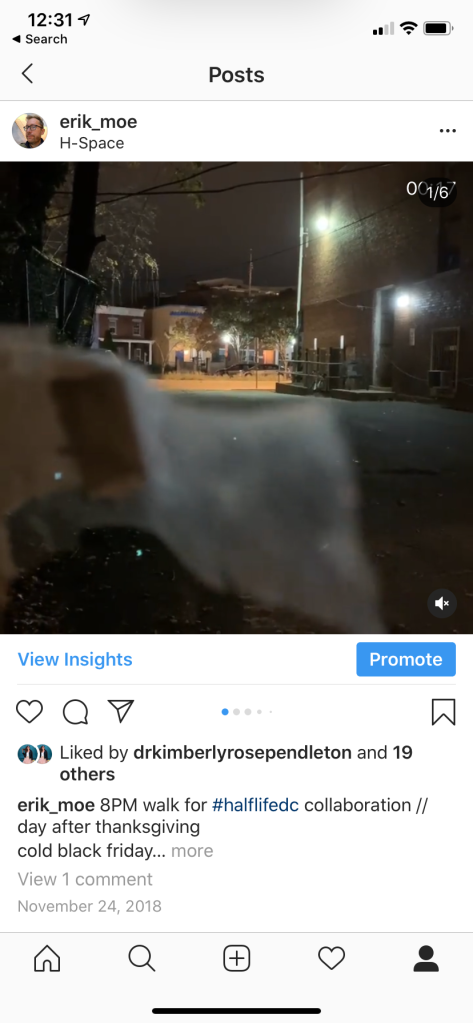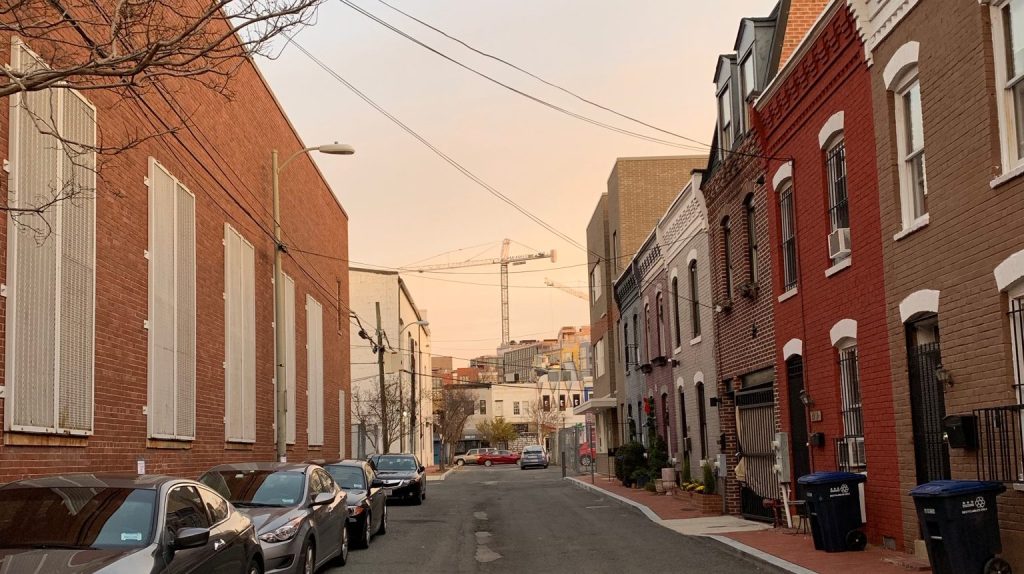The following was written for “Half/Life,” a zine accompanying the collaborative exhibition of the same name on view at H-Space (located on 9 1/2 Street NW in Washington, DC), through September 28, 2019. Zines are available now in the Future Cartographic store.

The half in Half/Life references the name of the street we set out to document (9 1/2 Street is one of only a few half-streets in D.C.’s street numbering scheme). Life refers to the 24-hour life of a block well known for its thriving nightlife. It also refers to the much quieter domestic lives inside its alley-facing residences, including those of Katherine and her husband Adam, their children Calvin and Mae, Kristin, her husband Russ, their daughter Eliza—born midway through the project, and myself (alone with my scattered social- and often antisocial-life).
The project grew out of a monthly breakfast art meet up hosted in my apartment. After a walk-themed writers’ residency, I suggested twenty-four walks, randomly scheduled, one for each clock hour. This became the skeleton of the project, understanding that we would each observe as many or as few hours as life’s demands permitted, as fit our very different processes as a painter, a choreographer, and a writer/artist, respectively. We also sought to encourage contemplation of life within the walls of our homes at these times alongside life outside in the alley.
Using a random number generator, we scheduled the twenty-four walks every other day in November and December. The schedule ensured we’d finish before Kristin’s due date, but didn’t account for the predominance of darkness and cold during that time of year. Six months later, after Kristin and Katherine each moved their growing families to larger homes elsewhere in the city, we supplemented these first observations with a round of twenty-four additional randomized walks nearer the summer solstice when the days grew long and the city hot and verdant.
Decay, Renewal, Displacement
In science, a half-life documents and measures something diminishing over time, as radioactive decay or a drug in the bloodstream. We knew that this past year on 9 1/2 Street would be a last opportunity to document aspects of a unique place that are diminishing over time. Ours is one of the last blocks in the U Street corridor to see major development. A years-long process to develop two properties long held by the city was moving forward. The towering 1887 Grimke elementary school (named for Archibald Grimke, journalist, civil rights leader, and one of Harvard Law’s first black graduates), home to pigeons and squatters, will finally be repurposed. To sweeten the complicated project for developers, a parking lot at the U Street end of 9 1/2 Street was added to the development deal. On early maps of D.C. an outpost of the Metropolitan Police stood on the lot, complete with horse stables outside my present day bedroom window. A mix of commercial, residential, and arts uses, along with a modern home for the African American Civil War Memorial Museum are planned.
Grit and decay of urban infrastructure is not something to be romanticized lightly. Itinerant photographers with no community standing have been criticized for “ruin porn” of decay in Detroit and elsewhere. The decline of buildings like these is evidence of decades of systemic economic apartheid and disinvestment in communities people of color have called home for generations. The two parcels slated for redevelopment on this block are among the last glaring scars from that chapter in U Street’s history. Developing them hardly means that decades of harm have been resolved. The geography of inequality is shifting elsewhere.
However, there is an aesthetic link between the culture of the city and the character of its streetscape. Go-Go, Hip-Hop and Punk sounds now played in the legendary nightclubs surrounding 9th and U, and on the car stereos and headphones that pass by, are genres inspired by the streets as they were in the decades before gleaming white Apple and Sephora stores arrived. The new 9 1/2 Street of clean lines, faux-brick and glass that will appear over the months ahead (the parking lot has closed for business and construction fences are going up as I type this) will not be of a kind with the gritty aesthetic that inspired D.C.’s music. Is this sanitization to be mourned, even if the re-use of the old school is a public good?
Don’t Mute D.C.
I avoid the word gentrification because it isn’t specific enough. It means different things to different people. Cultural erasure and displacement of long-time residents are two of the ills that the term bundles together for many. Others hear the word and picture shiny new things appearing where once they feared to walk.
In March, a neighbor in the high-end apartments at 8th and Florida (a vacant lot and site of a great weekend flea market until just a few years ago) lodged noise complaints against Central Communications, a store famous for playing D.C.’s signature Go-Go beats from outdoor speakers. The store sells Go-Go recordings, but its main business these days is as a T-Mobile retailer. For years, the music provided an upbeat afternoon soundtrack to the bottleneck intersection where Georgia Avenue spills Howard University’s campus towards LeDroit Park, Shaw, and Black Broadway. The store’s corporate parent silenced the music—until word of the newcomer’s complaint spread virally online. The #DontMuteDC movement was born, and today the music plays on. #DontMuteDC has become an organizing force mobilizing Go-Go music against cultural erasure and other social issues.
The bars and nightclubs at U and 9th receive many more noise complaints each week. Some negotiation between neighbors is inevitable when bedrooms and dance floors are mere feet apart, but what is the attraction of living in an area famous for nightlife, African-American music, LGBTQ bars, and Ethiopian culture if your first instinct is to shut them down?
The next wave of change on 9 1/2 Street will clean up the block’s appearance. It will change the nightlife culture, too. How much? And how long before developers buy out the intimate two-story clubs here, perhaps keeping their facades as decoration for new buildings, as has happened elsewhere nearby?
A Contemplative Practice
Beyond documenting this moment in time and culture on this bit of land, Half/Life explores the simple act of stepping outside to notice one’s immediate surroundings. What do we overlook in our rush to get to the grocery store, to drop the kids off at school, and to get home to our screens again?
In repeating this act of observing 9 1/2 Street, of stepping in to the wet, or hot, or dark elements repeatedly, I sometimes felt anxiety towards the task. After living on the block for nearly three years, hadn’t I discovered all there was to know? Without exception, the act of going outside to simply notice yielded unexpected experiences. Insight in to how many working people hold our 24-hour community together. A realization that a color, animal, plant, architecture, behavior, or play of light had been doing its thing all along humbly contributing to this place.
Do It For The ’Gram

I wrote what I saw on my walks in a small notebook and soon began taking photographs for each hour and posting both to Instagram (@erik_moe) as early, rapid-fire drafts of the 48 Half/Life poems (snippets of which appear in our collage paintings). I started to feel that these Instagram posts were a mild transgression in the context of that platform. Social networks are not optimized for subtlety and contemplation.
This afternoon as I write, friends and forgotten acquaintances have posted from the Parthenon in Greece, Yosemite National Park, the Louisiana Museum of Modern Art, beaches in Mexico and Santa Monica, a bookstore in Paris, and a gritty-looking alley in Rome.
Would I rather be in those places than contemplating my gritty-looking alley in D.C.? In a heartbeat. But I’m conflicted.
Is coming upon an unexpected firefly show among wildflowers at the edge of your own alley as important an encounter with nature as a trip to Yosemite? Is understanding something of a restaurant manager’s struggle to get out of work to spend time with his family waiting in a car outside as valuable a lesson in humanity as a trip to the ruins of ancient Greece?
Apples and oranges perhaps. But pursuing and sharing ever more beautiful lifestyle pics and the FOMO that results does not come at a trivial cost. Big crowds seeking quick photo-ops can overrun sensitive ecosystems, harm the character of a place, and cause damage to ancient artifacts. It is also unsustainable. Travel is a huge element of most people’s carbon footprint, and it doesn’t take very many flights to add your name to the list of the globe’s worst 1% of carbon emitters.
Might some level of renewed appreciation and search for beauty and meaning in our immediate surroundings be warranted?
—August 28, 2019
 [ Essay and full Half/Life zine available in print in the Future Cartographic store ]
[ Essay and full Half/Life zine available in print in the Future Cartographic store ]


Comments
One response to “What is the Half-Life of a Neighborhood?”
[…] We’ve put together collages, photographs, and a zine based on our observations. I’ve written an essay about the experience as well as 48 poems derived from observational walks during the Winter and […]